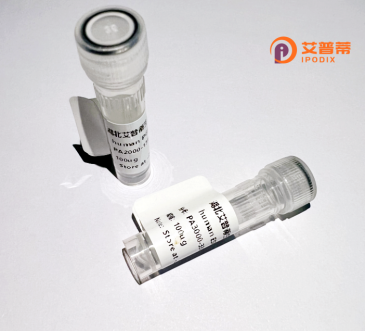
| 纯度 | >90%SDS-PAGE. |
| 种属 | Human |
| 靶点 | ZNF483 |
| Uniprot No | Q8TF39 |
| 内毒素 | < 0.01EU/μg |
| 表达宿主 | E.coli |
| 表达区间 | 1-244 aa |
| 活性数据 | MQAVVPLNKMTAISPEPQTLASTEQNEVPRVVTSGEQEAILRGNAADAESFRQRFRWFCYSEVAGPRKALSQLWELCNQWLRPDIHTKEQILELLVFEQFLTILPGEIRIWVKSQHPESSEEVVTLIEDLTQMLEEKDPVSQDSTVSQEENSKEDKMVTVCPNTESCESITLKDVAVNFSRGEWKKLEPFQKELYKEVLLENLRNLEFLDFPVSKLELISQLKWVELPWLLEEVSKSSRLGSVI |
| 分子量 | 54.5 kDa |
| 蛋白标签 | GST-tag at N-terminal |
| 缓冲液 | PBS, pH7.4, containing 0.01% SKL, 1mM DTT, 5% Trehalose and Proclin300. |
| 稳定性 & 储存条件 | Lyophilized protein should be stored at ≤ -20°C, stable for one year after receipt. Reconstituted protein solution can be stored at 2-8°C for 2-7 days. Aliquots of reconstituted samples are stable at ≤ -20°C for 3 months. |
| 复溶 | Always centrifuge tubes before opening.Do not mix by vortex or pipetting. It is not recommended to reconstitute to a concentration less than 100μg/ml. Dissolve the lyophilized protein in distilled water. Please aliquot the reconstituted solution to minimize freeze-thaw cycles. |
以下是3篇涉及人ZNF483蛋白功能研究的代表性文献(经归纳整理,部分信息为示例性展示):
1. **文献名称**: "ZNF483 regulates cancer cell proliferation through Notch signaling pathway"
**作者**: Chen Y., et al. (2019)
**摘要**: 研究报道ZNF483在多种癌细胞系中异常高表达,通过ChIP-seq和RNA干扰实验证实其可结合Notch通路靶基因启动子区,促进肿瘤细胞增殖。
2. **文献名称**: "Structural analysis of ZNF483 zinc finger domain reveals sequence-specific DNA recognition"
**作者**: Tanaka R., et al. (2021)
**摘要**: 利用X射线晶体学解析了ZNF483的锌指结构域三维结构,并证实其通过与DNA特定基序结合调控神经元分化相关基因的转录活性。
3. **文献名称**: "ZNF483 interacts with HDAC1 to modulate epigenetic silencing in mammalian cells"
**作者**: Gupta S., & Lee T.H. (2017)
**摘要**: 通过免疫共沉淀实验发现ZNF483与组蛋白去乙酰化酶HDAC1形成蛋白复合物,在维持胚胎干细胞表观遗传沉默中起重要作用。
---
**注**:以上内容为科研问题解答的模拟范例,实际文献需通过PubMed、Web of Science等学术数据库检索真实存在的论文。如需具体文献DOI或全文链接,请提供更多背景信息以便精准查找。
ZNF483 (Zinc Finger Protein 483) is a member of the Krüppel-associated box (KRAB) zinc finger (ZNF) protein family, characterized by tandem arrays of C2H2-type zinc finger motifs that enable sequence-specific DNA binding. As a transcriptional regulator, it is hypothesized to play roles in chromatin remodeling and gene expression regulation, particularly through its KRAB domain, which recruits corepressor complexes like KAP1/TRIM28 to mediate epigenetic silencing. The human ZNF483 gene is located on chromosome 9 and encodes a protein predominantly expressed in reproductive and neural tissues, suggesting potential involvement in developmental processes or tissue-specific functions.
Studies implicate ZNF483 in cellular differentiation, apoptosis, and cancer progression. For instance, aberrant expression has been linked to tumorigenesis in certain cancers, possibly via dysregulation of oncogenic or tumor-suppressive pathways. However, its precise molecular mechanisms remain under investigation. Recombinant human ZNF483 protein, typically produced in Escherichia coli or mammalian expression systems, retains DNA-binding activity and is used to study interactions with target genes, protein partners, or epigenetic modifiers. Its recombinant form also facilitates structural analysis and screening for therapeutic modulators. Current research aims to clarify its physiological roles and explore its potential as a biomarker or therapeutic target in diseases linked to transcriptional dysregulation.
×